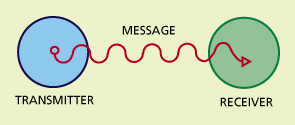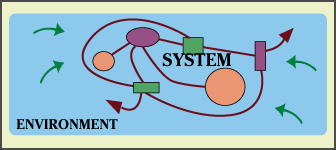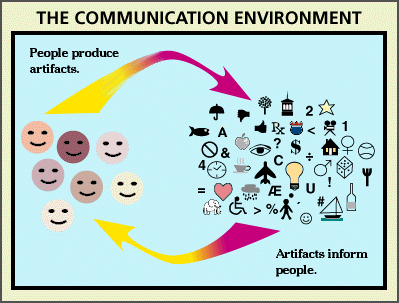 -- in fact too complex to be fully explained by the Shannon/Weaver model.
-- in fact too complex to be fully explained by the Shannon/Weaver model.

 TUTORIAL: Communication Environment
TUTORIAL: Communication EnvironmentINTRODUCTION . THE COMMUNICATION ENVIRONMENT . COMMUNICATION AND CULTURE . THE SOCIAL CONSTRUCTION OF REALITY . IDEOLOGY . TECHNOLOGY
The issue is this: Do meaningful thought and reason concern merely the manipulation of abstract symbols and their correspondence to an objective reality, independent of any embodiment?
Or do meaningful thought and reason essentially concern the nature of the organism doing the thinking - including the nature of its body, its interactions with its environment, its social character, and so on?
Though these are highly abstract questions, there does exist a body of evidence that suggests that the answer to the first question is no and the answer to the second is yes.
- George Lakoff
The "fundamental" Shannon/Weaver model of communication focuses on the process
by which a messsage sent by one communicator is received by another. However,
as this simple situation, which includes only two communicators, is expanded
to include additional transmitters and receivers, the sending and receiving
of messages becomes very complex -- in fact too complex to be fully explained by the Shannon/Weaver model.
-- in fact too complex to be fully explained by the Shannon/Weaver model.
The search for other explanatory models begins with the receiver. Human beings become informed as they perceive data by means of their senses, and as they organize this information and give it meaning. The development of the semiotic model explains this process in terms of signs, or perceptions that bring to mind concepts about the world. Signs can be arranged in elaborate systems of codes, including the very complicated codes that are called languages, and used as a means of communication.
While much communication takes place in one-on-one, or face-to-face, situations among individual human beings, communication can also take place in groups, including the very large groups that compose the audiences of the mass communication media. Thus, no communication is independent of the social environment within which it occurs. In fact, in social situations it can be said that one cannot not communicate.
Most theories of communication envision communication as a process that occurs by means of messages circulated within a system of interrelated senders and receivers.

Although scholars typically focus their attention on the system, the environment is also of considerable importance. For one thing, a system cannot survive without its environment. For another, a system's environment is active, and some of that activity necessarily impacts on the system.
Communication is carried on by individuals within the context of groups and with the use of signs whose meanings are established in part by negotiation among the members of the groups. Thus, human beings:
![]() The Importance of Everyday Life
The Importance of Everyday Life
You may accordingly like to think of culture - I often do - as an enormous pumpkin, hard to penetrate, full of uncharted hollows and recesses for cultural critics to get lost in, and stuffed with seeds of uncertain contents and destiny.
- Jacques Barzun
There is general agreement that human communication and human culture are related. There is little agreement as to what that means. Denis McQuail provides a summary definition
If we extract different points from these different usages, it seems that culture must have all of the following attributes.
- Denis McQuail 95
In the context used here, the term "culture" names the entire collection of human artifacts. This means that culture includes everything that might possibly be considered as "text," and that it therefore is the "what" that students of communication study in order to understand the "how" and "why" of the communication process.
The artifacts that humans create as they communicate with one another may become public, and in so doing, become part of the reality of others. It is these cultural artifacts, along with their associated meanings, that form the environment of human communication.

The meaning that one human assigns to a received message is based in part on the meanings that he or she has assigned to other messages in the past, and in part on the meanings that other humans have assigned to similar messages previously exchanged. In this way as individuals and their cultures interact, they are mutually responsible for the construction of the social reality of human life.
![]() 1021
1021
![]() 1533
1533
![]() 1534
1534
![]() 1535
1535
![]() 1536
1536
![]() 1537
1537
![]() 1541
1541
![]() 1542
1542